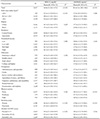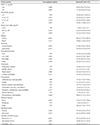Association between High-Density Lipoprotein Cholesterol and Vitamin D Levels in Adult Men in the Fifth Korea National Health and Nutrition Examination Survey
-
In Kyung Jung



- Received August 26, 2019 Revised October 24, 2019 Accepted November 12, 2019
- ABSTRACT
-
- Background
- Patients with metabolic syndrome had low high-density lipoprotein cholesterol (HDL-C) levels. Moreover, vitamin D deficiency is also related to metabolic syndrome. This study aimed to investigate the association between vitamin D and HDL-C levels.
- Methods
- To determine the association between HDL-C and vitamin D levels, 5,537 males who had no missing values were systematically selected from the fifth Korea National Health and Nutrition Examination Survey. Then, the association was investigated by a multivariable logistic regression analysis after adjusting for the effects of confounding factors on vitamin D and HDL-C levels, such as age, body mass index (BMI), sociodemographic factors, and lifestyle factors.
- Results
- In Korean men aged ≥20 years, the mean vitamin D and HDL-C levels were 18.3±0.2 ng/mL and 46.8±0.2 mg/dL, respectively. Moreover, the prevalence of low HDL-C levels was 29.2±0.8%. After adjusting for age, BMI, sociodemographic factors, and lifestyle factors, the risk of low HDL-C levels in the lowest quartile of vitamin D level was 1.296 (95% confidence interval [CI], 1.035–1.623) times higher and that in the second quartile of vitamin D level was 1.354 (95% CI, 1.086–1.690) times higher than that in the third quartile of vitamin D level (P<0.05).
- Conclusions
- The risk of low HDL-C levels is associated with vitamin D level after adjustment for age, BMI, sociodemographic factors, and lifestyle factors.
- REFERENCES
- REFERENCES
- 1. Natarajan P, Ray KK, Cannon CP. High-density lipoprotein and coronary heart disease: current and future therapies. J Am Coll Cardiol 2010;55(13):1283-1299.
[PubMed]2. Riggs KA, Rohatgi A. HDL and reverse cholesterol transport biomarkers. Methodist Debakey Cardiovasc J 2019;15(1):39-46.
[Article] [PubMed] [PMC]3. Bardagjy AS, Steinberg FM. Relationship between HDL functional characteristics and cardiovascular health and potential impact of dietary patterns: a narrative review. Nutrients 2019;11(6):1231.
[Article] [PubMed] [PMC]4. Brites F, Martin M, Guillas I, Kontush A. Antioxidative activity of high-density lipoprotein (HDL): mechanistic insights into potential clinical benefit. BBA Clin 2017;8:66-77.
[Article] [PubMed] [PMC]5. Bikle DD. Extraskeletal actions of vitamin D. Ann N Y Acad Sci 2016;1376(1):29-52.
[Article] [PubMed] [PMC]6. Marino R, Misra M. Extra-Skeletal effects of vitamin D. Nutrients 2019;11(7):1460.
[Article] [PubMed] [PMC]7. Oberoi D, Mehrotra V, Rawat A. “Vitamin D” as a profile marker for cardiovascular diseases. Ann Card Anaesth 2019;22(1):47-50.
[Article] [PubMed] [PMC]8. Sun X, Cao ZB, Tanisawa K, Ito T, Oshima S, Ishimi Y, et al. Associations between the serum 25(OH)D concentration and lipid profiles in Japanese men. J Atheroscler Thromb 2015;22(4):355-362.
[Article] [PubMed]9. Chaudhuri JR, Mridula KR, Anamika A, Boddu DB, Misra PK, Lingaiah A, et al. Deficiency of 25-hydroxyvitamin d and dyslipidemia in Indian subjects. J Lipids 2013;2013:623420.
[Article] [PubMed] [PMC]10. Park JE, Pichiah PBT, Cha YS. Vitamin D and metabolic diseases: growing roles of vitamin D. J Obes Metab Syndr 2018;27(4):223-232.
[Article] [PubMed] [PMC]11. Sarmiento-Rubiano LA, Angarita Ruidiaz JA, Suarez Dávila HF, Suarez Rodríguez A, Rebolledo-Cobos RC, Becerra JE. Relationship between serum vitamin D levels and HDL cholesterol in postmenopausal women from Colombian caribbean. J Nutr Metab 2018;2018:9638317.
[Article] [PubMed] [PMC]12. Ponda MP, Huang X, Odeh MA, Breslow JL, Kaufman HW. Vitamin D may not improve lipid levels: a serial clinical laboratory data study. Circulation 2012;126(3):270-277.
[Article] [PubMed] [PMC]13. Ponda MP, Liang Y, Kim J, Hutt R, Dowd K, Gilleaudeau P, et al. A randomized clinical trial in vitamin D-deficient adults comparing replenishment with oral vitamin D3 with narrow-band UV type B light: effects on cholesterol and the transcriptional profiles of skin and blood. Am J Clin Nutr 2017;105(5):1230-1238.
[Article] [PubMed] [PMC]14. Wieder-Huszla S, Jurczak A, Szkup M, Barczak K, Dołęgowska B, Schneider-Matyka D, et al. Relationships between vitamin D3 and metabolic syndrome. Int J Environ Res Public Health 2019;16(2):175.
[Article] [PubMed] [PMC]15. Ministry of Health and Welfare, Korea Centers for Disease Control and Prevention. Korea Health Statistics 2010: Korea National Health and Nutrition Examination Survey (KNHANES V-1) [Internet]. Cheongju: Korea Centers for Disease Control and Prevention; 2011;Accessed Feb 21, 2019]. Available from: https://knhanes.cdc.go.kr/knhanes/sub03/sub03_02_02.do16. Ministry of Health and Welfare, Korea Centers for Disease Control and Prevention. Korea Health Statistics 2011: Korea National Health and Nutrition Examination Survey (KNHANES V-2) [Internet]. Cheongju: Korea Centers for Disease Control and Prevention; 2012;Accessed Feb 21, 2019]. Available from: https://knhanes.cdc.go.kr/knhanes/sub03/sub03_02_02.do17. Ministry of Health and Welfare, Korea Centers for Disease Control and Prevention. Korea Health Statistics 2012: Korea National Health and Nutrition Examination Survey (KNHANES V-3) [Internet]. Cheongju: Korea Centers for Disease Control and Prevention; 2013;Accessed Feb 21, 2019]. Available from: https://knhanes.cdc.go.kr/knhanes/sub03/sub03_02_02.do18. Kweon S, Kim Y, Jang MJ, Kim Y, Kim K, Choi S, et al. data resource profile: the Korea National Health and Nutrition Examination Survey (KNHANES). Int J Epidemiol 2014;43(1):69-77.
[Article] [PubMed] [PMC]19. Yun YM, Song J, Ji M, Kim JH, Kim Y, Park T, et al. Calibration of high-density lipoprotein cholesterol values from the Korea National Health and Nutrition Examination Survey Data, 2008 to 2015. Ann Lab Med 2017;37(1):1-8.
[Article] [PubMed] [PMC]20. Alberti KG, Eckel RH, Grundy SM, Zimmet PZ, Cleeman JI, Donato KA, et al. Harmonizing the metabolic syndrome: a joint interim statement of the International Diabetes Federation Task Force on Epidemiology and Prevention; National Heart, Lung, and Blood Institute; American Heart Association; World Heart Federation; International Atherosclerosis Society; and International Association for the Study of Obesity. Circulation 2009;120(16):1640-1645.
[Article] [PubMed]21. Bahor TF, Higgins-Biddle JC, Saunders JB, Monterio MG. World Health Organization. AUDIT: the Alcohol Use Disorders Identification Test: guidelines for use in primary health care. 2nd ed. Geneva: World Health Organization; 2001.22. Kim J, Chu SK, Kim K, Moon JR. Alcohol use behaviors and risk of metabolic syndrome in South Korean middle-aged men. BMC Public Health 2011;11:489.
[Article] [PubMed] [PMC]23. Wang T, Sun H, Ge H, Liu X, Yu F, Han H, et al. Association between vitamin D and risk of cardiovascular disease in Chinese rural population. PLoS One 2019;14(5):e0217311.
[Article] [PubMed] [PMC]24. Wang H, Peng DQ. New insights into the mechanism of low high-density lipoprotein cholesterol in obesity. Lipids Health Dis 2011;10:176.
[Article] [PubMed] [PMC]25. Cho KH, Park HJ, Kim SJ, Kim JR. Decrease in HDL-C is associated with age and household income in adults from the Korean National Health and Nutrition Examination Survey 2017: correlation analysis of low HDL-C and poverty. Int J Environ Res Public Health 2019;16(18):3329.
[Article] [PubMed] [PMC]26. Králová Lesná I, Suchánek P, Stávek P, Poledne R. May alcohol-induced increase of HDL be considered as atheroprotective? Physiol Res 2010;59(3):407-413.
[PubMed]27. Jung IK. Association of Smoking status and high density lipoprotein-cholesterol in males in the fifth Korea National Health and Nutrition Examination Survey. Korean J Health Promot 2017;17(4):289-297.
[Article]28. Forey BA, Fry JS, Lee PN, Thornton AJ, Coombs KJ. The effect of quitting smoking on HDL-cholesterol - a review based on within-subject changes. Biomark Res 2013;1(1):26.
[Article] [PubMed] [PMC]
Table 3

Abbreviations: 25(OH)D, 25-hydroxyvitamin D; AUDIT, Alcohol Use Disorders Identification Test; CI, confidence interval; HDL-C, high-density lipoprotein cholesterol; N, unweighted frequency; SE, standard error.
aCalculated by complex sample descriptive statistics.
bCalculated by complex sample general linear model.
Table 4

Values are presented as odds ratio (95% confidence interval).
Abbreviations: 25(OH)D, 25-hydroxyvitamin D; AUDIT, Alcohol Use Disorders Identification Test; CI, confidence interval; KNHANES, Korea National Health and Nutrition Examination Survey; OR, odds ratio.
aAdjusted by BMI and age.
bAdjusted by factors in model 1 and sociodemographic factors; e.g., region, residence, household income, education, and occupation.
cAdjusted by factors in model 2 and life style factors; e.g., physical activity, smoking status, and alcohol use.
dCalculated by complex sample logistic regression analysis.


